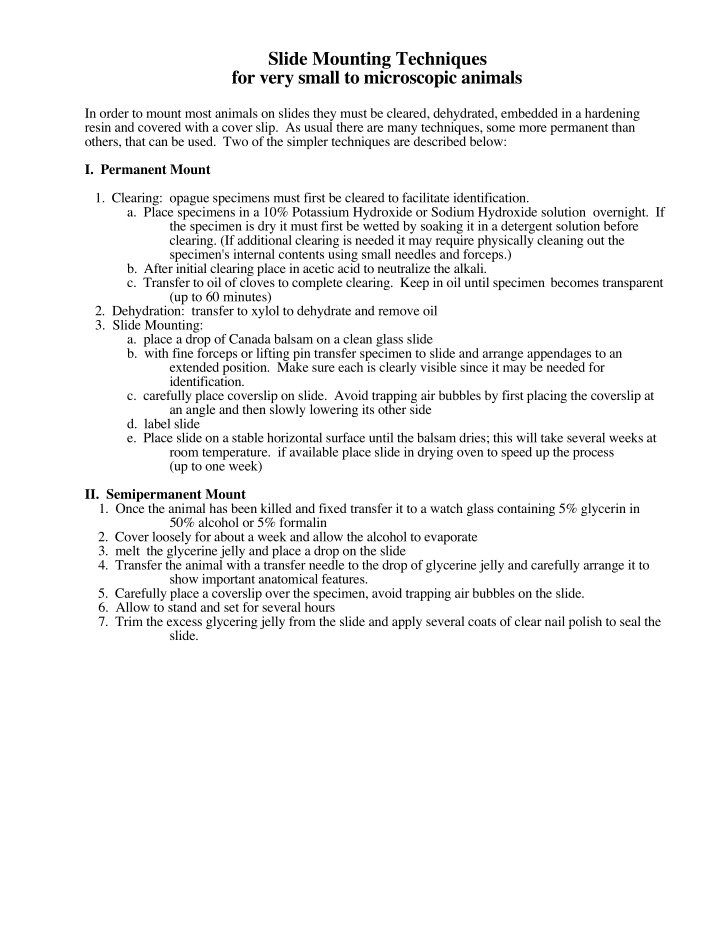



Slide Mounting Techniques for very small to microscopic animals In order to mount most animals on slides they must be cleared, dehydrated, embedded in a hardening resin and covered with a cover slip. As usual there are many techniques, some more permanent than others, that can be used. Two of the simpler techniques are described below: I. Permanent Mount 1. Clearing: opague specimens must first be cleared to facilitate identification. a. Place specimens in a 10% Potassium Hydroxide or Sodium Hydroxide solution overnight. If the specimen is dry it must first be wetted by soaking it in a detergent solution before clearing. (If additional clearing is needed it may require physically cleaning out the specimen's internal contents using small needles and forceps.) b. After initial clearing place in acetic acid to neutralize the alkali. c. Transfer to oil of cloves to complete clearing. Keep in oil until specimen becomes transparent (up to 60 minutes) 2. Dehydration: transfer to xylol to dehydrate and remove oil 3. Slide Mounting: a. place a drop of Canada balsam on a clean glass slide b. with fine forceps or lifting pin transfer specimen to slide and arrange appendages to an extended position. Make sure each is clearly visible since it may be needed for identification. c. carefully place coverslip on slide. Avoid trapping air bubbles by first placing the coverslip at an angle and then slowly lowering its other side d. label slide e. Place slide on a stable horizontal surface until the balsam dries; this will take several weeks at room temperature. if available place slide in drying oven to speed up the process (up to one week) II. Semipermanent Mount 1. Once the animal has been killed and fixed transfer it to a watch glass containing 5% glycerin in 50% alcohol or 5% formalin 2. Cover loosely for about a week and allow the alcohol to evaporate 3. melt the glycerine jelly and place a drop on the slide 4. Transfer the animal with a transfer needle to the drop of glycerine jelly and carefully arrange it to show important anatomical features. 5. Carefully place a coverslip over the specimen, avoid trapping air bubbles on the slide. 6. Allow to stand and set for several hours 7. Trim the excess glycering jelly from the slide and apply several coats of clear nail polish to seal the slide.
Slide Mounting Media Canada Balsam: thick balsam is diluted with xylol (xylene). Glycerin Jelly: can be purchased already prepared or made: 1.5g gelatin soaked in 100ml water overnight dissolve with gentle heating Add to 200 ml of glycerin add 1.0 g carbolic acid warm gently and stir for 10 minutes until homogenous when needed melt the glycerin jelly gently in warm water PVA Mounting Medium (Bioquip) Clearing and semipermanent medium for small arthropods, insect larvae, mites and spiders (substitute for Hoyer’s mounting medium) 1. specimen should be in alcohol 2. place drop of PVA on slide 3. place and arrange speciman 4. add coverslip 5. let stand for awhile 6. remove excess medium from around coverslip 7. slide must be ringed and sealed with clear fingernail polish Hoyer’s Mounting Medium Clearing and semipermanent medium for small arthropods, insect larvae, mites and spiders (substitute for Hoyer’s mounting medium) Composition: Dissolve 30g of pulverized gum arabic in 50ml of water Add 20ml glycerin Add and dissolve 125g of chloral hydrate Add 2g of iodine crystals Add 1g of potassium iodide Filter thrugh cotton wool 1. specimen should be in alcohol 2. place drop of PVA on slide 3. place and arrange speciman 4. add coverslip 5. let stand for awhile 6. remove excess medium from around coverslip 7. slide must be ringed and sealed with clear fingernail polish Euparal Mounting Medium (Bioquip) For wholemounts of small-bodied insects such as mosquitoes, aphids, thrips taken directly from 95% alcohol. (permanent substitute for Canada Balsam) Euparal essence is a thinning agent 1. speciman must be preserved in alcohol, if in formalin transfer to 70% alcohol 2. transfer to 95% alcohol and leave for a while 3. place drop of euparal on slide 4. place and arrange speciman 5. add coverslip 6. allow to dry and harden
Glycerine Jelly (Cabisco) A semipermanent mounting medium Composition: 1.5g gelatin soaked in 100ml water overnight dissolve with gentle heating add to 200ml of glycerine add 1.0g carbolic acid warm gently and stir for 10 minutes until homogenous 1. Once the animal has been killed and fixed, transfer to watch glass containing 5% glycerine in 50% alcohol or. 2. Cover loosely for about a week and allow the alcohol to evaporate 3. Melt glycerine jelly gently in warm water bath and place a drop on slide 4. Transfer animal with a trasfer needle to drop of glycerine jelly and arrange 5. Carefully cover with coverslip, avoid air bubbles 6. Allow to stand and set for several hours 7. Trim excess glycerine jelly from around coverslip 8. Apply several coats of clear nail polish to seal Kleermount in Xylene (Carolina) A permanent neutral mounting medium that will not turn acid or darken with age. Replaces canada balsam. Speciman must be dehydrated in alcohol/xylene series Canada Balsam A general permanent mounting medium for dehydrated whole specimens or microtome sections Speciman must be dehydrated in alcohol/xylene series Stains Borax Carmine (Grenacher) 1. Make a concentrated solutin of carmine by adding the powder to 4% borax solution and boiling the mixture for 1/2 hour 2. The liquid is diluted with an equal volume of 70% alchol 3. Allow to stand 4. filter 5. stain whole mounts about 10 minutes 6. differentiate in acid alcohol (4 drops HCl to 100ml 70% EtOH)
Recommend
More recommend